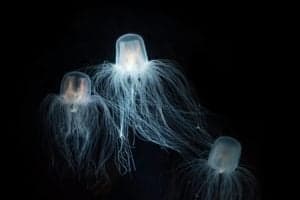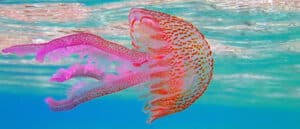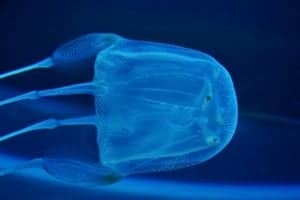Jellyfish are fascinating creatures of the sea. They have no central brain, no stomach, no bones, and no heart — but are alive nonetheless. Through a complex and interconnected system of nerves, jellyfish find food, move to cleaner waters, and sting their prey or predators.
Often thought of as purple or pink, jellyfish actually come in many different colors. Some are rarer than others, though. Discover the nine different colors of jellyfish, from rarest to most common.

The Enigma of Color in Jellyfish
It’s hard to categorize how rare the color of jellyfish is, as some species of jellyfish change their color based on their habitat and diet. For example, the moon jellyfish is naturally opaque or transparent colored but can become pink or purple after eating larval crustaceans.
There are some colors that jellyfish just don’t come in — like black. Even though some jellyfish have the color black in their name, no jellyfish species exists (that humans have discovered yet) that have a naturally black pigment in their bodies. However, deep indigo and purple can present as an almost black-looking color at first glance for many jellyfish.
The 9 Colors of Jellyfish (Rarest to Most Common)
Green
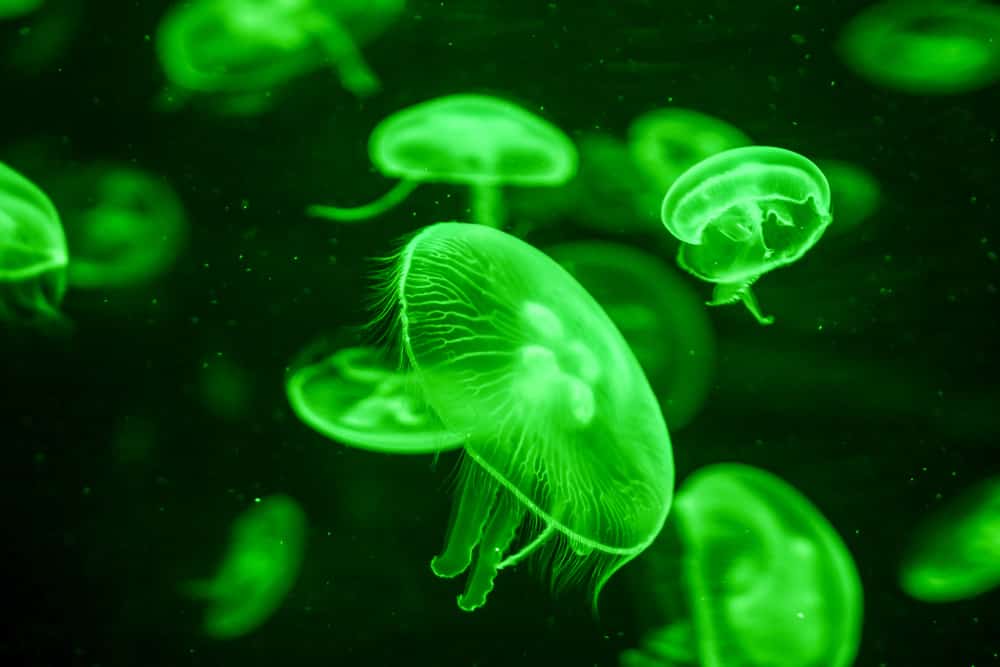
Translucent jellyfish with the GFP protein glow green instead of blue.
©underworld/Shutterstock.com
The only green jellyfish you’ll find among Earth’s waters is when a bioluminescent jellyfish has the specific Green Fluorescent Protein (GFP) ability rather than blue. Most notably, this protein is isolated from Aequorea victoria, a translucent jellyfish when it’s not emitting light.
Brown, Yellow, or Gold
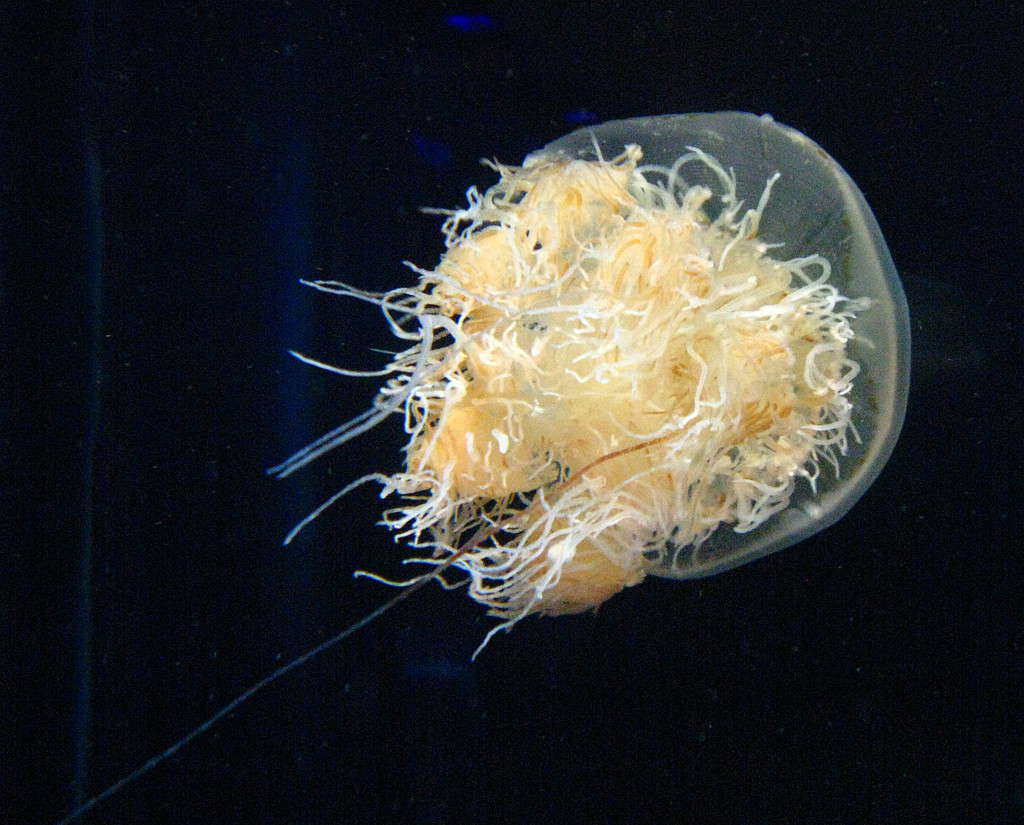
Nomura’s jellyfish can sometimes have brown coloring, which departs from the usual light pink or purple.
©I, KENPEI, CC BY-SA 3.0, via Wikimedia Commons – License
Not many jellyfish have predominantly brown, yellow, or gold bells — or arms, for that matter. The upside-down jellyfish has a brownish, blueish bell and tan arms. Some subspecies in the western Pacific Ocean have yellow or gold colorings. Overall, a brown, yellow, or gold jellyfish is one of the most uncommon jellyfish colors on earth.
White
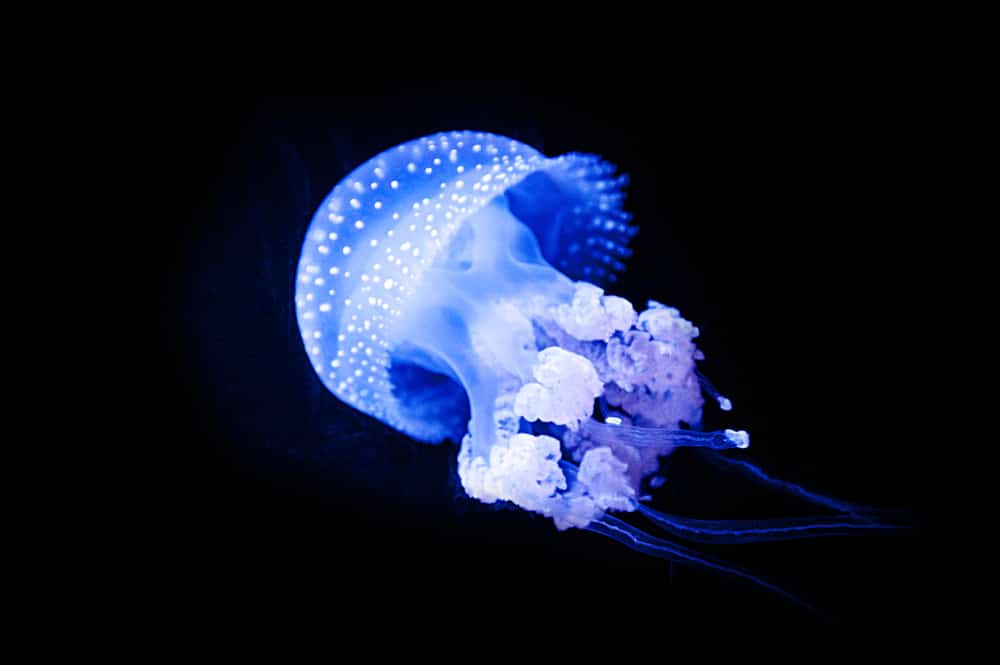
The white-spotted jellyfish is an invasive species.
©Filip Kubala/Shutterstock.com
There aren’t many white jellyfish in the oceans, as most are translucent instead of pure white. There are two major exceptions as far as jellyfish colors go: the mushroom cap jellyfish and the Australian spotted jellyfish. The Australian spotted jellyfish, also called the white-spotted jellyfish, is an invasive species when they’re found anywhere outside of the western Pacific Ocean.
Blue
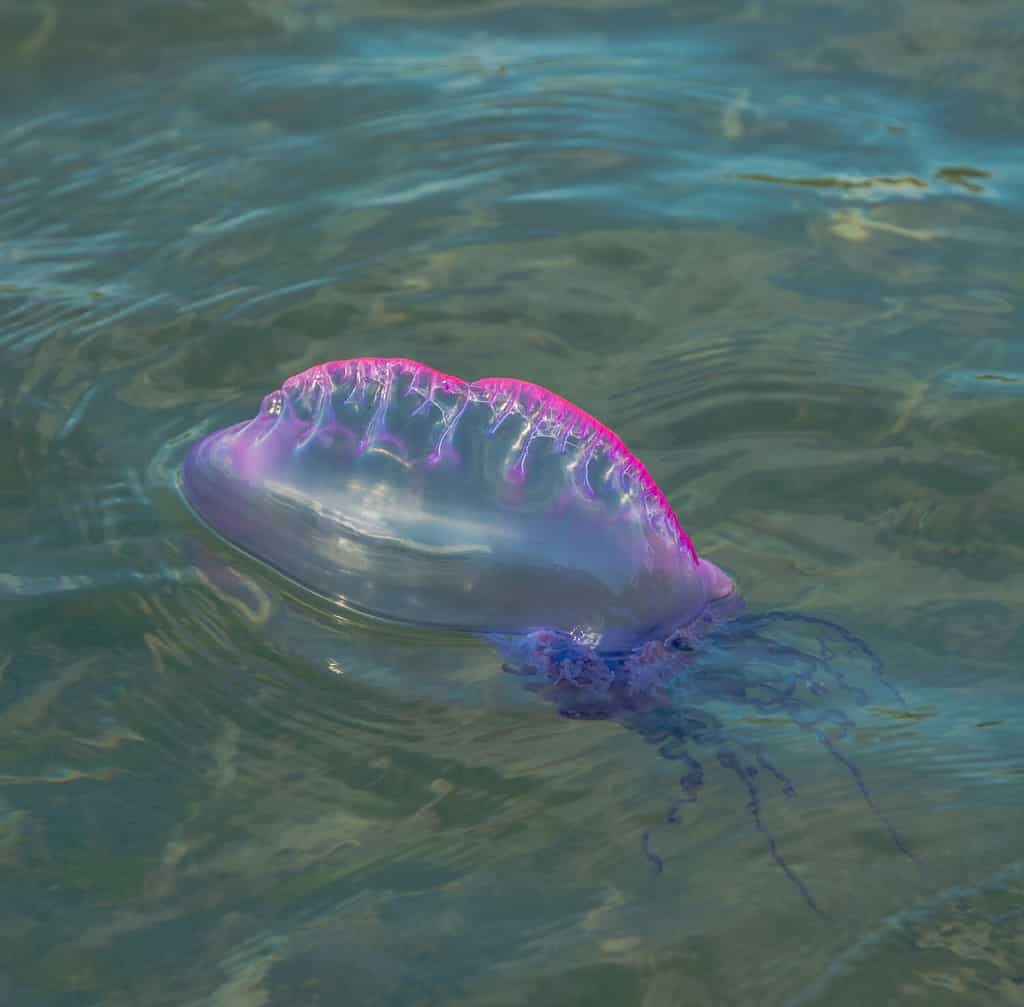
Portuguese man o’ war jellies have blue, pink, and purple parts of their body, but they’re mostly different hues of blue.
©Broadbelt/Shutterstock.com
One of the most infamous jellyfish in global waters is the Portuguese man o’ war. It’s a semi-translucent jellyfish with blue, pink, and purple tints. In actuality, these creatures are zooids, which are closely related to jellyfish but not of the same colony. There’s also the blue button jellyfish and the cannonball jellyfish — though some arguments maintain the latter is actually white.
Pink
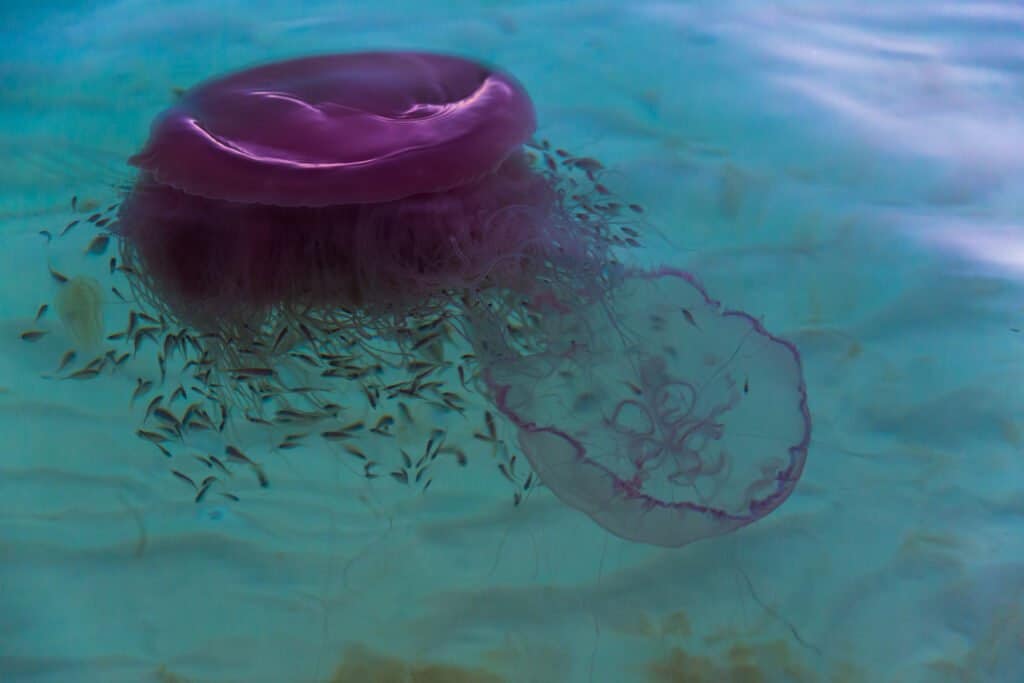
The pink meanie preys on smaller jellyfish.
©iStock.com/olya_steckel
You’ll rarely see more than a handful of jellyfish look exclusively pink. The pink meanie jellyfish, a cannibalistic species, has a deep blush color. One of the other few pink jellies is a mauve stinger that is mauve and darker pinks and browns rather than a vibrant fuschia.
Red and Orange
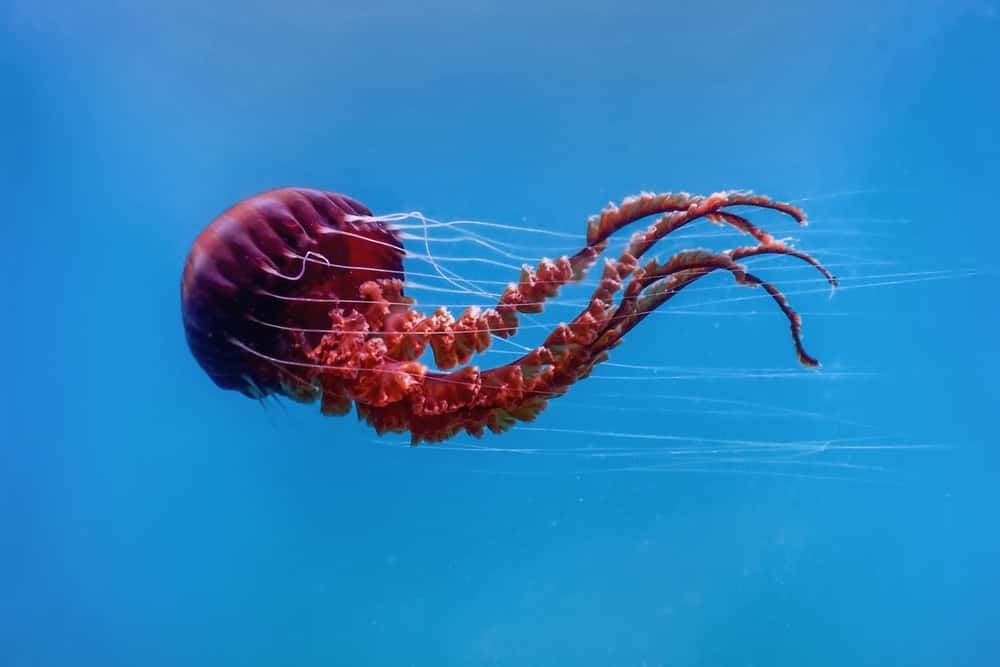
Many species of jellyfish in the world’s oceans are red, like the lion’s mane or the red jellyfish.
©Allexxandar/Shutterstock.com
Though the red species are some of the rarest jellyfish in the world, a good handful of jellyfish range between the colors of red and orange. These include the red lion’s mane jellyfish, the red sea nettle, red jellyfish, the bloody-belly comb fish, and the yet unnamed species found in a deep-sea dive in 2021 off the coast of Newport, Rhode Island. It’s one of two that belong to the Poralia genus and is blood red.
Purple

The cauliflower jellyfish has a predominantly purple body, though its bell is differently colored.
©SaltedLife/Shutterstock.com
Often lumped in with pink-colored jellyfish, purple jellyfish are actually more common than they might seem. Thanks to pop culture, most people are correct to consider that many species of jellyfish that they might see in the deep waters of the world have lavender to indigo colors. The immortal jellyfish, the flower hat jellyfish, the cauliflower jellyfish, and Pelagia noctiluca are just some of the purple jellyfish floating in the ocean.
Colorless

You’ll most often find crystal jellies, a colorless jellyfish, off the west coast of North America.
©iStock.com/GaryKavanagh
If you’ve seen a jellyfish washed up on the beach from the Atlantic or Pacific oceans, there’s a good chance that it was a moon jellyfish. They’re the most common jellyfish found along the North American coasts. Their translucent bodies may have a tint of pink or blue, but they are predominantly see-through. Other jellyfish that are colorless include the box jellyfish, the crystal jellyfish, and the Irukandji jellyfish. Depending on the species, comb jellies are also colorless. However, they often use their bioluminescence when swimming to ward off predators.
Patterned or Gradient

These black sea nettles aren’t black at all, but several different colors.
©Ken Wolter/Shutterstock.com
Many jellyfish have more than one color and the combinations of their markings vary widely. Take, for example, the black sea nettle (which is not black at all). Instead, its bell is deep purple and transforms into corally-pink arms with white stingers.
Bonus Color: Bioluminescence

The majority of jellyfish have some sort of bioluminescent capability to use against predators or for prey.
©synthetick/Shutterstock.com
While not a color, bioluminescent jellyfish sometimes look like they glow blue, green, or white when observed in the water. By definition, bioluminescence describes the light that organisms produce and emit from their bodies. About 50% of jellyfish have some sort of bioluminescent property. That’s not too surprising when you find out that the majority of organisms in the world’s oceans have some sort of bioluminescent capability. Sharks, bacteria, jellyfish, and other animals all use bioluminescence.
Some other animals use their bioluminescence to lure prey into their mouths. Most jellyfish that are bioluminescent emit light as a defense to ward off predators. Scientists have yet to understand the extent to which jellyfish choose to use their bioluminescence. Some of the most common jellyfish that are bioluminescent include:
- Comb jellies.
- Crystal jelly.
- Moon jelly.
Rare Species Do Not Equal Rare Colors
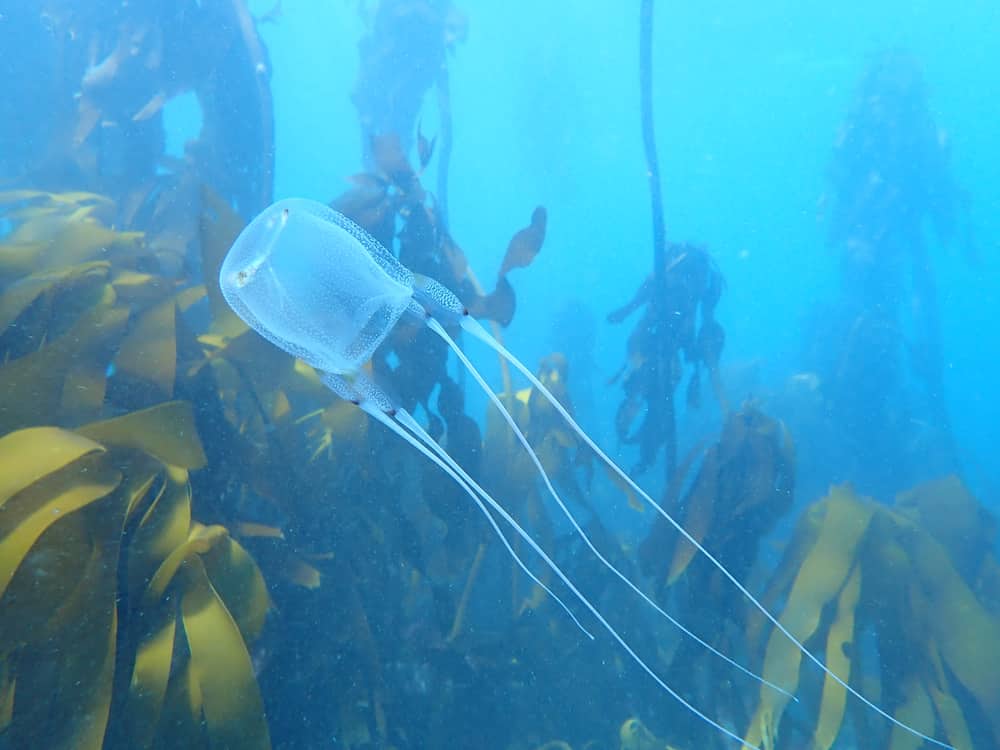
Box jellyfish, while rare, have the common transparent coloring.
©Katherine Wallis/Shutterstock.com
After reading the list above, you may think it’s odd that some of the rarest types of jellyfish have some of the most common coloring. Interestingly, some of the rarest jellyfish have common colors because they need to survive in their specific habitats.
The spotted box jellyfish is one of the most elusive jellyfish in the world — it’s only been captured on film twice in history. However, it’s a patterned jellyfish. Because there are so many different patterns that suit the diversity of environments in which jellyfish live, it’s impossible to categorize each pattern into a category to rank.
Similarly, the phantom jellyfish is a dark pink-purple color. This massive jelly, most recently found near the ocean floor in Monterey, California, has a gradient of pink and purple. Those are two pretty common jellyfish colors. The jelly needs to be these dark, muted colors to maintain its stealthiness when sneaking up on prey. Prey doesn’t venture often toward the ocean floor where phantom jellyfish live, so stealth and grabbing it in massive, dark tentacles could mean eating today, or not eating for another week.
Finally, some rare species of box jellyfish are colorless or completely transparent. Again, they have the same need for anonymity as the phantom jellyfish. Camouflage works both ways for jellyfish: catching prey and hiding from predators. Because they don’t have a centralized brain to make complex evasive decisions, nor do they have dorsal fins (or fins of any kind) to swim away, the best method of defense for a jellyfish faced with a predator is to hide in plain sight.
Jellies Come in All the Colors of the Rainbow
As scientists continue to explore the depths of the ocean, they’ll find more species and subspecies of jellyfish with unique colors and markings. If you’re in the ocean and have the chance to see a patterned jellyfish, it’ll be an incredible experience to behold.
Next up, learn more about the things jellyfish like to eat or what predators commonly use jellyfish as staples in their diets.
Summary of the 9 Colors of Jellyfish (Rarest to Most Common)
| Color | Rarity | |
|---|---|---|
| 1. | Green | Most rare; only found in specimen where Green Fluorescent Protein (GFP) is present |
| 2. | Brown, Yellow, or Gold | Rare because invasive species only native to the Indian Ocean |
| 3. | White | Rare because invasive species only native to Indian Ocean |
| 4. | Blue | Portuguese man o’ war |
| 5. | Pink | Pink meanie jellyfish |
| 6. | Red and Orange | More common; red lion’s mane jellyfish, the red sea nettle, red jellyfish, the bloody-belly comb fish |
| 7. | Purple | Fairly common; immortal jellyfish, the flower hat jellyfish, cauliflower jellyfish, and Pelagia noctiluca |
| 8. | Colorless | Common; box jellyfish, crystal jellyfish, Irukandji jellyfish, comb jellies |
| 9. | Patterned or Gradient | Common; Black sea nettle |
The photo featured at the top of this post is © LanKS/Shutterstock.com
Thank you for reading! Have some feedback for us? Contact the AZ Animals editorial team.




